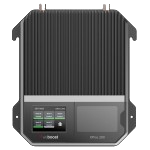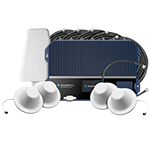Reliable Cell Signal in Schools Enhances Education & Safety
Why Schools Should Improve Cellular Connectivity
K-12 schools, colleges, and universities are notorious for poor cellular coverage.
Up until a few years ago, that was acceptable. Desired, even. It prevented students from being distracted by their phones. A teacher using a cell phone jammer to block cell service at a school in Florida is a good example of this. However, that is no longer the case. Technology is now an integral part of education.
Poor cellular connectivity hinders the effective integration of technology in the classrooms. Not to mention, it also poses a huge safety and security risk, which should be top priority. To bridge this gap, schools should consider implementing cell phone signal boosters to improve connectivity.
We understand that many educational institutions face financial constraints when it comes to implementing robust cellular signal boosters. Fortunately, schools can leverage grants and funding opportunities to promote safety and security by enhancing cellular connectivity.
We fix poor cell phone signal! Find the right signal booster for you:




Why Do Schools Have Bad Cellular Reception?
Most schools weren't built with cellular connectivity in mind. They were built for safety and durability.
4G, LTE, and 5G signals have a hard time penetrating school buildings and efficiently propagating indoors. Exterior and interior building materials block, absorb, reflect, and degrade cell signals.
Think of the layers of brick, steel, thick concrete, and energy-efficient material that make up most schools. Then multiply that by the numerous classrooms, floors, and other interior interferences.
This results in limited indoor coverage and dead zones.
Strong Cell Coverage Improves Teaching, Learning, and Safety
Smartphones, smart devices, and IoT bring new possibilities to education.
Enhances Safety
School safety is of paramount importance, and strong cellular connectivity is crucial in emergencies. This includes (but is not limited to) storms, lockdowns, and – sadly - active shooter situations.
The ability to call parents, loved ones, and first responders in dangerous situations cannot be overstated. Safety alert systems reliant on cellular signals also need adequate reception to send texts and email notices.
Effective two-way communication ensures the safety of all and the success of response efforts.
More Student Engagement
Many studies show that student engagement increases when using mobile devices in classrooms. Not only is it fun and educational for all age groups, but it opens the door to different ways of participation that a board, pen, and paper, can't offer. For example, students can virtually connect with peers from different locations, fostering a global learning community and broadening their perspectives.
In addition, tech-driven lessons allow teachers to see what topics students are struggling with in real-time. They can then instantly address it, encouraging discussions and improving information retention.
If there is no cell service in the classroom:
- Students can't access the necessary material.
- Teachers can't give instantaneous feedback.
Equal Learning Opportunity
Not all schools have the means to provide every student with mobile devices. Having reliable service allows students with smartphones to use their own devices in the classroom. The institution can then lend its mobile equipment to those who need it most. This way everybody has equal opportunity to learn, participate, and engage with tech.
Improved Efficiency for Teachers
Educators spend a lot of time grading and planning. Automation saves teachers tons of time. They can update lessons on the fly, simplify grading, make complex topics easier to understand, and much more. Most importantly, teachers can give students feedback quicker than before. Poor cell coverage hinders the learning process and takes away from the instructor's personal time.
Prepares Students for the Future
Mobile tech in the classroom prepares students for an ever-evolving digital world. They gain creative, communication, research, and digital skills sought after in the workforce. Without usable cell signals, they don’t have the opportunity to practice and master them.
Doesn’t WiFi Cover Everything I Need for Indoor Coverage?
Unfortunately, no.
While WiFi is the standard for wireless communication, it has its drawbacks.
First and foremost, congestion.
With hundreds of students, teachers, and guests connecting to one network at the same time, the network overloads. This results in slow, unreliable, and unprotected connections for students, guests, and staff.
How are students supposed to participate in interactive lessons? How are teachers supposed to deliver quality lessons if their applications won't load?
Improving cell connectivity helps offload congestion and enhance security.
Secondly...
In the case of a downed WiFi network, internet access and communication across all campus buildings go down with it. With reliable cellular coverage, your institution will have a secure network to fall back on.
How to Get Signal in Schools?
As mentioned above, WiFi is the current standard for network connectivity. However, having reliable in-building cellular is equally important. It expedites communication, reduces WiFi congestion, and acts as a secondary network system.
The most cost-effective way to blanket schools with reliable cell phone signals is with cell phone signal boosters. They're also known as Passive Distributed Antenna Systems (DAS).
These systems take your existing outside signal, even if weak, and deliver it even stronger inside. They boost 4G and 5G signals operating across frequency bands 700 – 2100 MHz. This is accomplished using outdoor cellular antennas, an amplifier, indoor cellular antennas, and coaxial cables. The coax cables help bypass signal-blocking materials, eliminating the main issue. Dead zones and weak signal areas within the school can be eliminated, enabling seamless access to a wealth of educational materials. Depending on the size of the school, deployment can take a few days to a week.
Active DAS or Hybrid DAS are more powerful, but costlier alternatives.
Active DAS uses more complex equipment than Passive DAS. Components are connected with fiber optic or ethernet cables. This allows the system to carry the strongest possible cellular signal across long distances, making Active DAS perfect for larger buildings. It’ll provide wider coverage and stronger reception. Depending on your unique needs, carrier approvals may be needed from every cellular provider whose signal you want to enhance in your school. Thus, deployment can be lengthy. Call us at 1-800-887-1961 to discuss Active DAS.
Hybrid DAS is very similar to Active DAS. The main difference is that Hybrid DAS also incorporates coaxial cable. This makes it cheaper than Active DAS and faster to deploy. Performance surpasses that of Passive DAS. With our partner Zinwave, we can turn any WilsonPro system into a Hybrid DAS. Give us a call at 1-800-887-1961 for more info.
Most administrators go with cellular boosters for schools to solve their signal woes.
Visit Cell Signal Boosters vs Distributed Antenna Systems to learn more.
Education Grants for Cellular Signal Boosters Available
Recognizing the importance of robust cell reception in education, various state and federal programs are available to support schools in their efforts to enhance connectivity. These programs provide financial assistance to institutions seeking to install cell phone signal boosters amongst other things. By taking advantage of these programs, schools can implement cellular signal boosters to enhance education and safety without budgetary concerns.
- Bureau of Justice Assistance’s STOP School Violence Program : Aims to prevent violence in schools by implementing behavioral threat assessments and/or intervention teams, technological solutions, and other school safety strategies that increase school safety. Instructions on how to apply can be found here.
- Department of Justice’s School Violence Prevention Program (SVPP) : Goal is to improve security at schools and on school grounds through the implementation of evidence-based school safety programs and technology. Instructions on how to apply can be found .
- CARES Act Education Emergency Relief Fund : Purpose is to address and mitigate the effects of the COVID-19 pandemic, including its impact on the social, emotional, mental health, and academic needs of students. While the application deadline has already passed, if your school district has taken advantage of this program, funds can be used towards communication technology like cellular boosters. Deadline to obligate funds is fast approaching for the ESSER II Fund (September 30, 2023) and ESSER III Fund (September 30, 2024). Assessing your cellular signal needs is of the essence. We can help draw up an estimate for your submission.
There are many other state and federal programs available to improve education and safety. Grants.gov, ed.gov, and schoolfinder.gov are great places to look.
To increase the chances of securing grants, schools must present a compelling case for why cellular signal boosters are essential for safety and security. Data on existing dead zones, weak signal areas, or communication challenges during emergencies should be provided. Schools can also highlight how cell phone boosters will enable seamless access to online resources, digital learning platforms, and real-time collaboration among students and teachers. This showcases the long-term value and sustainability of the project beyond safety considerations.
Wilson Amplifiers Case Study: Marian University
The Michael A. Evans Center for Health Sciences at Marian University is one of the safest, most eco-friendly buildings on campus. Consequently, cell coverage was nonexistent in most of the building. The threat of tornadoes had driven people to the building’s basements more than once. Other emergencies could present themselves at any moment. Having no signal was simply unacceptable for an institution that values its students' safety.

Due to budget concerns, the University couldn't invest in a large-scale solution. Wilson Amplifiers created a system design with the WilsonPro 1100 unit (now discontinued). It was within their budget and covered their desired key areas.
Installation took two days.
Once the booster was powered on, students and educators could make calls, send texts, and access the web from areas where it was impossible before. The IT director was very pleased with the results.
Each carrier’s signal increased significantly. In some cases, it was even stronger than the signal outside.
The WilsonPro 1100 has been replaced by the weBoost for Business 200 Installed.

For education institutions up to 35,000 sq ft. Professionally installed.
Buy Now at $3,799.99
For larger school buildings. Include site surveys and professional installations.
Call Us: 1-800-887-1961Enhance Your Schools Cell Coverage Today!
Investing in cellular signal boosters or active DAS is a proactive step toward creating a safe, technologically advanced educational environment. It’s time for schools to embrace the potential of cellular connectivity and provide a transformative learning experience for all. No matter the size, scope, and situation, our signal experts can design a custom DAS for your school.
Services we provide:
- FREE floor plan analysis with detailed heatmaps & coverage expectations.
- FREE consultation adhering to your requirements and budgets.
- Equipment selection from only the best.
- Site survey from certified wireless technicians.
- Professional turnkey installation & expert project management.
Call us (1-800-887-1961) or email us (pro@wilsonamplifiers.com) today to improve cell coverage in your K-12 school, college, or university.
Interested in Learning More? Check Out Our Signal Boosting Info Center


Money Back Guarantee

Technical Support